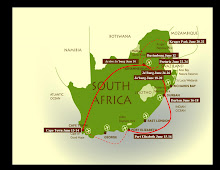HOEDSPRUIT--Throughout my two days exploring the South African wilderness, I kept thinking of a Rudyard Kipling-inspired name to describe our search for leopards. After spending two hours in search of the most elusive of the Big Five, I concluded with “How the leopard avoided tourists.”
I never did find out a definitive answer about why the lion, elephant, rhinoceros, water buffalo and leopard were called the Big Five. The most credible story I heard was those animals pose the biggest threat to humans.
For nearly 18 hours over three days, I went on three separate safaris on the eastern edge of South Africa. Neither the cold, nor the lack of leopard sightings or minimal sleep deterred me from enjoying seeing animals in their natural settings.
Sunday we were taken on a night drive through Kruger National Park. Without the interruptions of rural life the moon and the stars appeared brighter. (Apparently the park is the size of Israel. An added bonus was there were not blockades — on the animals from neighboring game reserves.)
Our guide for the evening turned off the lights to the truck and allowed us to sit beside a tree without any lights or any sounds for nearly five minutes. It was then the park began to come alive as crickets, rustling in the neighboring bushes and the flight of birds could all be heard without amplification.
Sunday night we saw elephants, wildebeests, desert foxes, jackals and white rhinos during our drive. There were about 18 of us on the safari truck Sunday. Most of us were disappointed we did not see the mysterious leopard, which we were told primarily comes out at night.
Our guide told us to be optimistic as we drove to the park’s Orpen entrance to leave for the night. He said people have seen members of the Big five on the way back to their accommodation. ...
My extremities were nearly numb when we met our safari organizer to take us back to our lodge in Hoedspruit. With most of my focus expended on finding a warm seat and enjoying it, I nearly missed what was right in front of me.
A heard of nearly 100 water buffalo were crossing the road at a frantic pace. Their jaywalking blocked the road, but also allowed everyone to get pictures close to the beasts. It was too dark to take any pictures that could distinguish the dark, mud-colored buffalos from the night, but that did not stop anyone from trying.
Before our driver could get up to speed again he slammed his brakes just as quickly. There was a pride of lions on the left of the road! There were at least two females, an adolescent male and a full grown lion — and its full-grown mane — in the group, just 15 feet away from the road.
Again, it was too dark to take salvageable pictures. The awe at being so close to the king of beasts was depicted an image for a story that will be told thousands of times before I die. It’s a near-certainty the tale will get taller as the years go on because there was not photographic evidence to weigh down such a meaty story.
There was still not a sighting of the leopard. With a full 12 hours of sightseeing scheduled for Monday, spotting the last of the big five was considered, at the time, a matter of just that.
Tuesday, June 22, 2010
How the leopard avoided tourists
Labels:
Big Five,
Kruger National Park,
leopards,
lions,
safari,
South Africa
Subscribe to:
Post Comments (Atom)



No comments:
Post a Comment